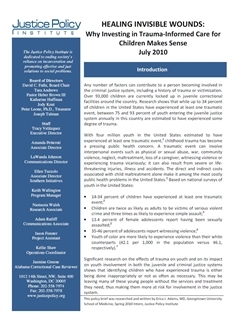
Any number of factors can contribute to a person becoming involved in the criminal justice system, including a history of trauma or victimization. Over 93,000 children are currently locked up in juvenile correctional facilities around the country. Research shows that while up to 34 percent of children in the United States have experienced at least one traumatic event, between 75 and 93 percent of youth entering the juvenile justice system annually in this country are estimated to have experienced some degree of trauma.
Youth in correctional facilities already face significant challenges related to their incarceration and justice involvement, including separation from their families, communities, education and other positive social networks. But youth who have experienced trauma will be even more acutely affected. In addition, there is risk of re-traumatization by staff and other people in correctional facilities. Addressing a child’s trauma through the public health system before the child becomes involved in the justice system, or if necessary while in the justice system, is critical to promoting the well-being of the child, his family and the community.
Download
Sanando las Heridas Invisibles
Healing Invisible Wounds is available in Spanish with many thanks to Maria Ortiz, LMSW–College Assistant Professor & Assistant Field Coordinator at New Mexico State University for her translation.